2. 同济大学 土木工程学院,上海 200092
2. College of Civil Engineering, Tongji University, Shanghai 200092, China
高强钢与普通钢相比具有更高的屈服强度和抗拉强度,因此在相同的受力条件下可以采用更小的截面尺寸,达到降低结构自重,显著减少单位建筑面积用钢量、焊接和涂刷工作量的目的[1],在建筑工程中得到越来越广泛的应用.高温下钢材的力学性能会发生明显下降,造成火灾下建筑结构的破坏.了解高强钢的高温力学性能,是进行高强钢结构抗火设计、保护火灾下高强钢建筑安全性的理论前提与基础.
目前,一些学者进行了火灾高温条件下钢材力学性能的研究.Schneider与Lange[2-4]对7种不同化学成分和交货状态的商业S460高强钢进行了高温材性试验,研究发现S460钢高温屈服强度相较于欧洲规范明显偏低.Qiang等[5-7]采用恒温加载和恒载升温两种方式对高强钢S460N和S690进行了试验研究,得到两种钢材在20~700 ℃内的力学性能和破坏模式.通过试验结果与国外标准以及相关研究文献的比较,发现各国规范并不适用于高强钢S460N和S690,且多数偏于不安全,具有相近常温屈服强度的S690和BISPLATE 80钢高温力学性能仍表现出较大不同.Ranawaka[8]和Mahendran[9]分别对冷轧高强钢高温力学性能进行了试验研究.Ranawaka的研究材料包括厚度分别为0.6 mm、0.8 mm、0.9 mm的普通钢G250和高强钢G550试件,试验方法包括稳态试验、瞬态试验和ISO标准试验.研究发现在200 ℃~500 ℃间高强钢与普通钢关于屈服强度的变化规律有明显区别,当温度超过400 ℃后,高强钢强度降低得更快,且厚度对钢材性能影响不大;高强钢与普通钢在200 ℃时延性均为最低,低温下普通钢延性更好,但温度升高到650 ℃后两者基本一致.Chiew等[10]通过对RQT-S690高强钢的研究发现,钢材在400 ℃以下具有良好的抗火性,温度超过400 ℃后强度急剧下降而延性增加.
在国内,同济大学的李国强等[11-13]分别对用于门式钢架结构的16Mn钢、制作冷弯型钢的日本标准SM41钢、10.9级高强度螺栓常用的20MnTiB钢进行了试验研究,并利用实验数据拟合得到不同钢材高温下强度与弹性模量的模型.陈驹等[14]对5 mm厚高强度钢BISPLATE 80进行了41组稳态试验和16组瞬态试验,试验结果表明相关规范对于屈服强度和稳态试验得到弹性模量值的预测偏于保守,而对于瞬态试验得到的弹性模量又不安全;BISPLATE 80钢与普通钢的弹性模量折减系数和屈服强度折减系数在22 ℃~540 ℃之间相近,温度超过540 ℃之后两种钢材的差别较大.
之前的研究表明,高强钢的高温力学性能和普通钢存在明显区别,不同国家和地区生产的不同型号高强钢的高温力学性能也存在差异,国产高强钢抗火设计不宜套用普通钢或者国外产高强钢模型.本文对国产Q550高强钢进行试验研究,并根据试验结果建立Q550钢高温本构关系模型.
1 试验 1.1 试验仪器试验在同济大学工程结构抗火试验室完成,所用仪器为高温电子材料试验机,见图 1.主机最大负荷为300 kN,采用交流伺服机及伺服驱动器,加载速率可控制在0.001~250 mm·min-1.加热炉采用GW900高温炉,见图 2,工作温度范围为200~1 100 ℃,炉温最小分辨率为0.1 ℃,均温段长度为150 mm.加热炉分上、中、下三段加热,每段配备一个侧插K型热电偶,高温试验中,将另一K型热电偶用耐高温布绑扎于试件中部,用以测量试件温度.试件变形测量选用接触式高温引伸计,测量精度为0.001 mm.
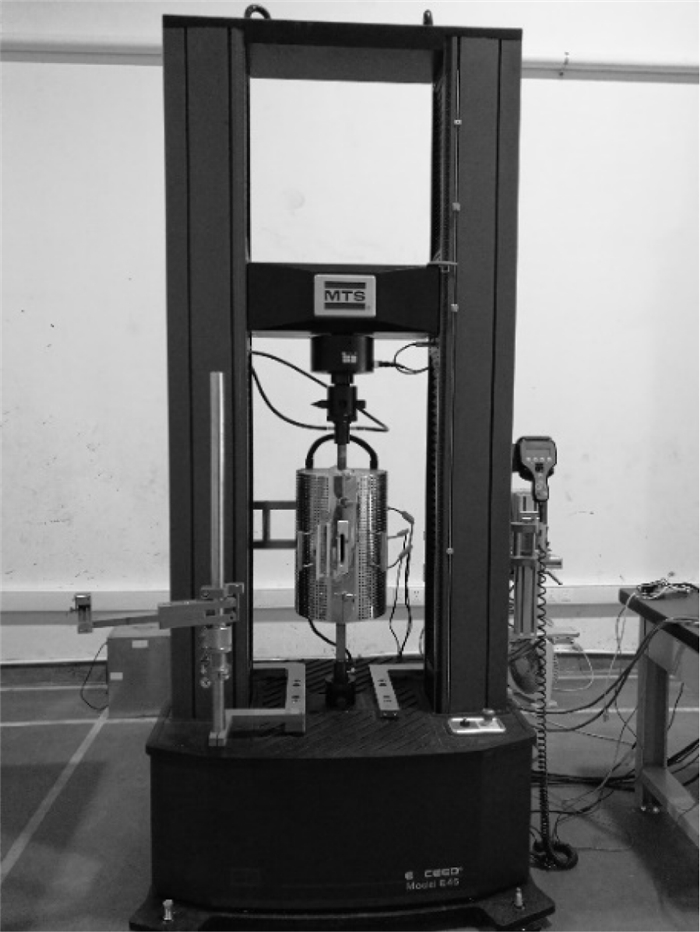
|
图 1 试验机 Fig.1 Testing machine |
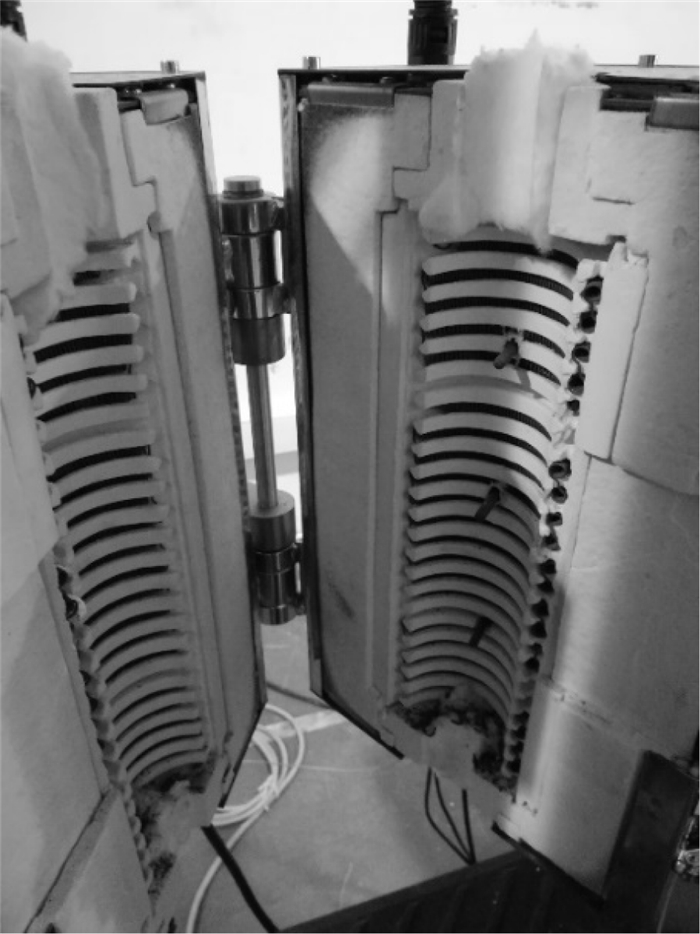
|
图 2 高温炉 Fig.2 Heating furnace |
试验所需试件由20 mm厚国产Q550钢板制成,化学成分如表 1所示.试件所采用形状和尺寸按中国标准《GB/T 228.1—2010金属材料室温拉伸试验方法》[15]和《GB/T4338—2006金属材料高温拉伸试验方法》[16]执行,见图 3.
| 下载CSV 表 1 Q550高强钢板化学成分表 Tab.1 Chemical constitution of high strength Q550 steel in the tests |
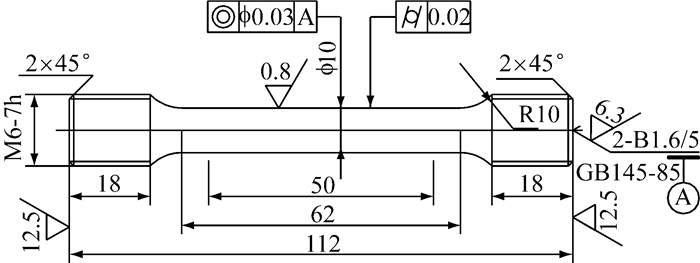
|
图 3 试验试件尺寸(单位:mm) Fig.3 Geometry of the specimens(Unit: mm) |
试验采用稳态试验方法,选择10 ℃·min-1的恒定升温速率将试件加热到指定温度,然后保温15 min,待试件温度通长均匀后开始加载,直至断裂.加载过程中采用应变速率控制,常温试验参考GB/T 228.1-2010,应变速率为0.015 min-1;高温试验参考GB/T4338-2006,应变速率采用0.003 min-1.试验温度点包括20(常温),200,300,400,450,500,550,600,700和800 ℃.常温下进行3个试件测量,其余每个温度点下进行2个试件测量,试件共计21根.
2 试验结果与分析 2.1 试验现象试件破坏状况如图 4所示,不同温度下试件表面颜色变化明显:200 ℃时,试件表面呈现金黄色金属光泽;300 ℃时表面为蓝色;400~450 ℃时为墨绿色;500~600 ℃时变为黑色;700 ℃和800 ℃时钢材氧化现象明显,表皮剥落严重,呈深灰色.
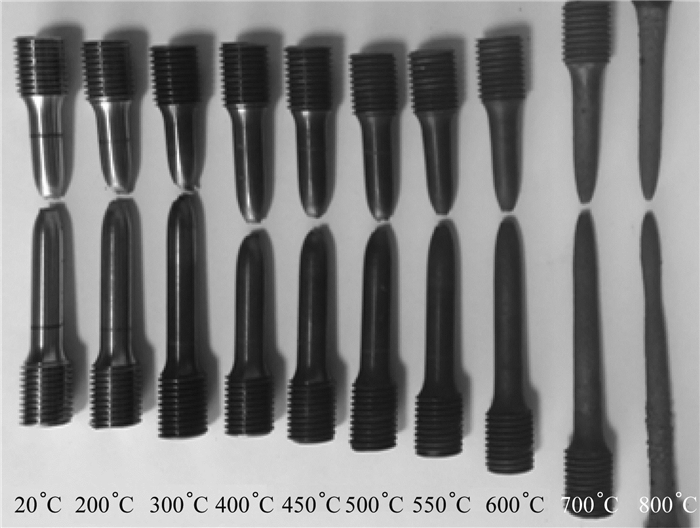
|
图 4 不同温度下Q550钢试件破坏状况 Fig.4 Failure modes of Q550 specimens at various elevated temperatures |
试件断口形貌如图 5所示.200 ℃时试件沿45°方向断裂,其余20~500 ℃各温度点上断口呈现明显杯口状,550~800 ℃时断口为锥形杯状.所有试件在断裂时均出现明显颈缩现象;700~800 ℃断口缩至极小.
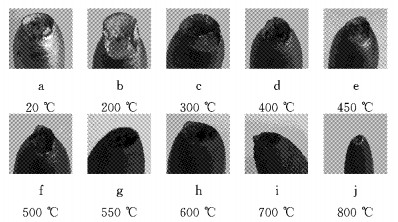
|
图 5 不同温度下Q550钢试件断口形貌 Fig.5 Fracture morphology of Q550 specimens at various elevated temperatures |
图 6为Q550高强钢在不同温度下的应力-应变关系曲线.其中20~550 ℃的曲线包括开始加载到断裂全过程,600~800 ℃的曲线由于断裂时延伸率过大,只绘制到应变0.3.从图 6中可知,Q550高强钢应力-应变关系曲线在常温与高温下均无明显屈服平台.曲线基本形状随温度升高发生明显变化.300 ℃后随温度升高,曲线弹性段和强化段缩短,下降段趋于平缓.

|
图 6 Q550钢应力-应变关系曲线 Fig.6 Stress-strain curves of Q550 steel at elevated temperatures |
Q550高强钢高温力学性能参数试验结果平均值及其折减系数如表 2所示.折减系数是该温度下力学性能参数试验结果平均值与常温试验结果平均值的比值.试验中同一温度下不同试件所得结果偏差不超过2%,试验数据离散性小,故每个试件数据不一一列出.
| 下载CSV 表 2 Q550高强钢高温力学性能参数值及折减系数 Tab.2 Mechanical properties and reduction factors of high strength Q550 steel at elevated temperatures |
从表 2中可知,Q550高强钢常温弹性模量值略高于普通钢;400 ℃以内,随着温度升高,弹性模量值缓慢减小;当钢材温度高于500 ℃,其折减系数下降速率明显加快.图 7比较了本文得到的Q550高强钢弹性模量折减系数与部分规范中材料模型(如CECS200[17]、EC3[18]、AS4100[19]、ECCS[20]、AISC[21])以及其他文献[5-6, 12, 14]中试验结果.图中ET为温度T时弹性模量,E20为常温时弹性模量.可见,不同钢材弹性模量试验值具有很强的离散性.与Q550钢相比,SM41[12]钢结果较为接近,BISPLATE 80[14]偏大而S460N[6]和S690[5]均偏小.国内外相关规范[17-21]中高温弹性模量的材料模型基本上是基于普通钢试验得到,均低于本文试验数据.
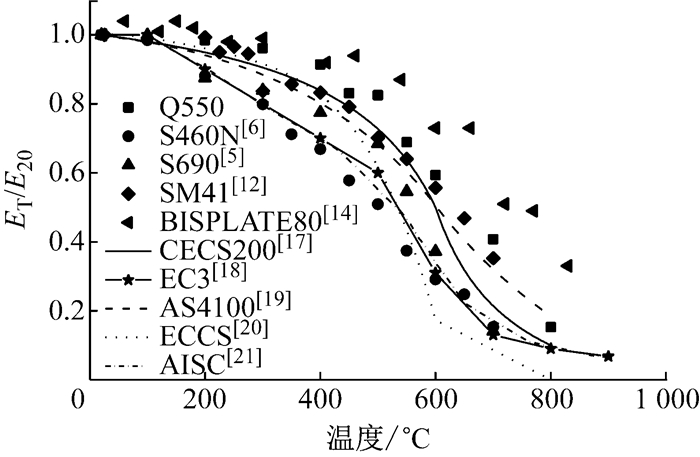
|
图 7 高温弹性模量折减系数比较 Fig.7 Comparison of elastic modulus reduction factors at elevated temperatures |
钢材高温屈服强度定义尚无统一标准,CECS200、EC3分别取1%和2%应变对应强度;ECCS规定400℃后取0.5%应变作为名义应变,当温度低于400 ℃时,则在0.2%(20℃时)和0.5%应变之间线性差值;AS4100对于屈服强度的应变水平没有具体规定.本试验屈服强度采用1.0%应变对应的强度.图 8显示Q550钢屈服强度折减系数试验值与部分规范中材料模型(如CECS200、EC3、AS4100、ECCS)以及其他文献[5-6, 14]的试验结果对比,其中S460N、S690和BISPLATE 80屈服强度均采用2.0%应变对应强度.fy, T为温度T时屈服强度,fy, 20为常温时屈服强度.

|
图 8 高温屈服强度折减系数比较 Fig.8 Comparison of yield strength reduction factors at elevated temperatures |
结合表 2和图 8可知,200 ℃时,屈服强度值相对于常温值有一定程度增加;300 ℃时屈服强度值则与常温结果相当;此后,随着温度升高,折减系数逐步减小.S460N和BISPLATE 80屈服强度折减系数在300~800 ℃内比本文试验值偏大;当温度低于500 ℃时,S690值小于Q550,600~800 ℃内两种钢材折减系数接近.与Q550试验值相比,CECS200规范值较为接近,EC3规范值相对偏大,而AS4100和ECCS规范值明显偏小.
2.3.3 极限强度由表 2可知,200~300 ℃内,Q550钢极限强度相较于常温值有一定程度增加.400~800 ℃内,极限强度折减系数随温度升高而减小,700 ℃后损失绝大部分强度.图 9显示Q550钢极限强度折减系数试验值和部分学者[5-6, 10, 12, 14]的研究结果对比.其中,fu, T和fu, 20分别为温度T时和常温时的极限强度.从图中可以看出,300 ℃后,SM41、S460N、S690的极限强度折减系数曲线与本文高强钢试验值较接近.400~700 ℃内,与Q550极限强度折减系数相比,BISPLATE 80钢试验结果偏大,而RQT-S690钢偏小.

|
图 9 极限强度折减系数比较 Fig.9 Comparison of ultimate strength reduction factors |
由表 2可知,Q550钢常温断后伸长率约为17%,体现常温下具有较好的延性.温度升高到200 ℃时,断后伸长率出现了明显下降,约为常温值的85%,钢材脆性增强.300~450 ℃内断后伸长率与常温值相当.此后,随温度升高,断后伸长率急剧增大.700 ℃后,断后伸长率可达到常温的5倍以上,表明钢材在此温度上具有极高的延性.
3 拟合公式目前,对于评估钢材高温力学性能尚无标准方法,不同学者根据自身研究成果提出不同模型,但由上文分析可知,国产Q550高强钢并不适用.为方便工程应用,本文分别采用多项式和美国国家标准与技术研究院(NIST)的研究人员提出的钢材高温通用材料模型[22-23]进行拟合.
3.1 弹性模量多项式拟合公式为
| $ \begin{array}{l} {\mathit{E}_\mathit{T}}{\rm{/}}{\mathit{E}_{{\rm{20}}}}{\rm{ = - 8}}{\rm{.132 \times 1}}{{\rm{0}}^{{\rm{ - 10}}}}{\mathit{T}^{\rm{3}}}{\rm{ - 1}}{\rm{.062 \times 1}}{{\rm{0}}^{{\rm{ - 6}}}}{\mathit{T}^{\rm{2}}}{\rm{ + }}\\ \;\;\;\;\;\;{\rm{3}}{\rm{.167 \times 1}}{{\rm{0}}^{{\rm{ - 4}}}}\mathit{T}{\rm{ + 0}}{\rm{.988}}\;{\rm{320^\circ C}} \le \mathit{T} \le {\rm{800}}\;{\rm{^\circ C}} \end{array} $ | (1) |
NIST通用材料模型拟合公式为
| $ \begin{array}{l} {\mathit{E}_\mathit{T}}{\rm{/}}{\mathit{E}_{{\rm{20}}}}{\rm{ = exp}}\left[{{\rm{-}}\frac{1}{2}} \right.{\left( {\frac{{\mathit{T-}{\rm{20}}}}{{{\rm{782}}{\rm{.1}}}}} \right)^{{\rm{142}}{\rm{.1}}}}{\rm{-}}\\ \;\;\;\;\;\;\;\;\;\;\;\;\;\frac{1}{2}\left. {{{\left( {\frac{{\mathit{T - }{\rm{20}}}}{{{\rm{580}}{\rm{.4}}}}} \right)}^{{\rm{3}}{\rm{.803}}}}} \right]\\ \;\;\;\;\;\;\;\;\;\;\;\;{\rm{20}}\;{\rm{^\circ C}} \le \mathit{T} \le {\rm{800}}\;{\rm{^\circ C}} \end{array} $ | (2) |
弹性模量试验值和模型拟合曲线对比如图 10所示.

|
图 10 弹性模量试验值和拟合公式曲线比较 Fig.10 Comparison between the proposed equations and test data of elastic modulus |
多项式拟合公式为
| $ \frac{{{\mathit{f}_{{\rm{y, }}\mathit{T}}}}}{{{\mathit{f}_{{\rm{y, 20}}}}}}{\rm{ = }}\left\{ \begin{array}{l} - {\rm{3}}{\rm{.115 \times 1}}{{\rm{0}}^{{\rm{ - 6}}}}{\mathit{T}^{\rm{2}}}{\rm{ + 9}}{\rm{.075 \times 1}}{{\rm{0}}^{{\rm{ - 4}}}}\mathit{T}{\rm{ + 0}}{\rm{.983}}\;{\rm{1}}\\ \;\;{\rm{20^\circ C}} \le \mathit{T} \le {\rm{300}}\;{\rm{^\circ C}}\\ {\rm{1}}{\rm{.578 \times 1}}{{\rm{0}}^{{\rm{ - 11}}}}{\mathit{T}^{\rm{4}}}{\rm{ - 1}}{\rm{.657 \times 1}}{{\rm{0}}^{{\rm{ - 8}}}}{\mathit{T}^{\rm{3}}}{\rm{ - 2}}{\rm{.907 \times }}\\ \;\;{\rm{1}}{{\rm{0}}^{{\rm{ - 6}}}}{\mathit{T}^{\rm{2}}}{\rm{ + 4}}{\rm{.736 \times 1}}{{\rm{0}}^{{\rm{ - 3}}}}\mathit{T}{\rm{ + 0}}{\rm{.1347}}\\ \;\;\;{\rm{300}}\;{\rm{^\circ C}} \le \mathit{T} \le {\rm{800}}\;{\rm{^\circ C}} \end{array} \right. $ | (3) |
NIST通用材料模型拟合公式为
| $ \begin{array}{l} \frac{{{\mathit{f}_{{\rm{y, T}}}}}}{{{\mathit{f}_{{\rm{y, 20}}}}}}{\rm{ = exp}}\left[{{\rm{-}}\frac{1}{2}} \right.{\left( {\frac{{\mathit{T-}{\rm{20}}}}{{{\rm{495}}{\rm{.3}}}}} \right)^{{\rm{4}}{\rm{.389}}}}{\rm{ + }}\\ \;\;\;\;\;\;\;\;\frac{1}{2}\left. {{{\left( {\frac{{\mathit{T}{\rm{-20}}}}{{{\rm{6}}{\rm{.479 \times 1}}{{\rm{0}}^{\rm{4}}}}}} \right)}^{{\rm{0}}{\rm{.443 2}}}}} \right]\\ \;\;\;\;\;\;\;\;{\rm{20}}\;{\rm{^\circ C}} \le \mathit{T} \le {\rm{800}}\;{\rm{^\circ C}} \end{array} $ | (4) |
屈服强度试验值和模型拟合曲线对比如图 11所示.
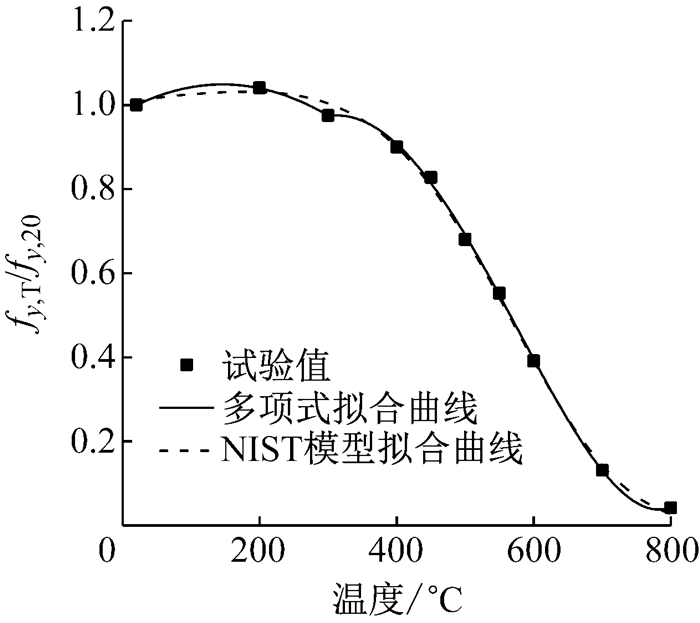
|
图 11 屈服强度试验值和拟合公式曲线比较 Fig.11 Comparison between the proposed equations and tests data of yield strength |
多项式拟合公式为
| $ \begin{array}{l} \frac{{{\mathit{f}_{{\rm{u, }}\mathit{T}}}}}{{{\mathit{f}_{{\rm{u, 20}}}}}}{\rm{ = 1}}{\rm{.659 \times 1}}{{\rm{0}}^{{\rm{ - 11}}}}{\mathit{T}^{\rm{4}}} - {\rm{2}}{\rm{.253 \times 1}}{{\rm{0}}^{{\rm{ - 8}}}}{\mathit{T}^{\rm{3}}}{\rm{ + 6}}{\rm{.218 \times }}\\ {\rm{1}}{{\rm{0}}^{{\rm{ - 6}}}}{\mathit{T}^{\rm{2}}}{\rm{ - 2}}{\rm{.49 \times 1}}{{\rm{0}}^{{\rm{ - 4}}}}\mathit{T}{\rm{ + 1}}{\rm{.002}}\\ {\rm{20}}\;{\rm{^\circ C}} \le \mathit{T} \le {\rm{800}}\;{\rm{^\circ C}} \end{array} $ | (5) |
NIST通用材料模型拟合公式为
| $ \begin{array}{l} \frac{{{\mathit{f}_{{\rm{u, }}\mathit{T}}}}}{{{\mathit{f}_{{\rm{u, 20}}}}}}{\rm{ = exp}}\left[{{\rm{-}}\frac{1}{2}} \right.{\left( {\frac{{\mathit{T-}{\rm{20}}}}{{{\rm{462}}{\rm{.1}}}}} \right)^{{\rm{3}}{\rm{.769}}}}{\rm{ + }}\frac{1}{2}\left. {{{\left( {\frac{{\mathit{T}{\rm{-20}}}}{{{\rm{1}}\;{\rm{771}}}}} \right)}^{{\rm{0}}{\rm{.941 2}}}}} \right]\\ \;\;\;\;\;\;\;\;\;\;\;\;\;\;\;\;\;\;\;\;\;\;{\rm{20}}\;{\rm{^\circ C}} \le \mathit{T} \le {\rm{800}}\;{\rm{^\circ C}} \end{array} $ | (6) |
极限强度试验值和模型拟合曲线对比如图 12所示.
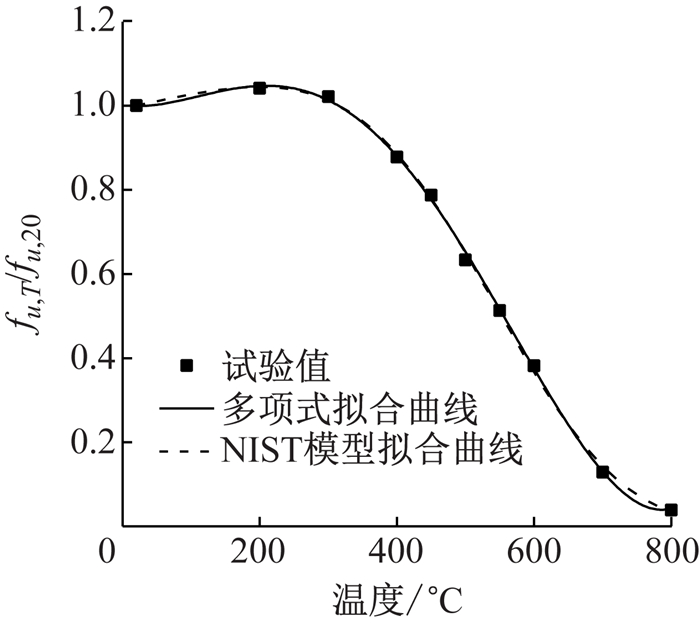
|
图 12 极限强度试验值和拟合公式曲线比较 Fig.12 Comparison between the proposed equations and tests data of ultimate strength |
多项式拟合公式为
| $ \frac{{{\mathit{\varepsilon }_{{\rm{u, }}\mathit{T}}}}}{{{\mathit{\varepsilon }_{{\rm{u, 20}}}}}}{\rm{ = }}\left\{ \begin{array}{l} {\rm{1}}\;\;\;\;\;\;\;\;\;\;\;\;\;\;{\rm{20}}\;{\rm{^\circ C}} \le \mathit{T} \le {\rm{450}}\;{\rm{^\circ C}}\\ {\rm{1}}{\rm{.636 \times 1}}{{\rm{0}}^{{\rm{ - 7}}}}{\mathit{T}^{\rm{3}}}{\rm{ - 2}}{\rm{.267 \times 1}}{{\rm{0}}^{{\rm{ - 4}}}}{\mathit{T}^{\rm{2}}}{\rm{ + }}\\ \;\;\;\;\;\;\;\;\;\;{\rm{0}}{\rm{.1124}}\mathit{T - }{\rm{18}}{\rm{.63}}\\ \;\;\;\;\;\;\;\;\;\;{\rm{450}}\;{\rm{^\circ C < }}\mathit{T} \le 800\;{\rm{^\circ C}} \end{array} \right. $ | (7) |
NIST通用材料模型拟合公式
| $ \begin{array}{l} \frac{{{\mathit{\varepsilon }_{{\rm{u, }}\mathit{T}}}}}{{{\mathit{\varepsilon }_{{\rm{u, 20}}}}}}{\rm{ = 0}}{\rm{.887}}\;{\rm{9 + 26}}{\rm{.44 \times }}\\ \left[{{\rm{1-}}} \right.{\rm{exp}}\left. {\left( {{\rm{-}}{{\left( {\frac{{{\rm{T-20}}}}{{{\rm{891}}{\rm{.8}}}}} \right)}^{{\rm{6}}{\rm{.492}}}}} \right)} \right]\\ \;\;\;{\rm{20}}\;{\rm{^\circ C}} \le \mathit{T} \le {\rm{800}}\;{\rm{^\circ C}} \end{array} $ | (8) |
式中,εu, T为温度T时的断后伸长率,εu, 20为常温时断后伸长率.
断后伸长率试验值和模型拟合曲线对比如图 13所示.

|
图 13 断后伸长率试验值和拟合公式曲线比较 Fig.13 Comparison between the proposed equations and tests data of elongation |
美国国家标准与技术研究院提出钢材高温通用材料模型来模拟高强钢的高温本构关系,模型表达式如式9.此模型屈服前采用直线表示,屈服点后表达式为5参数(k1、k2、k3、k4、n)模型.本文利用此公式对Q550高强钢高温应力-应变关系曲线进行拟合,得到不同温度的拟合参数值如表 3所示.图 14将模型曲线与试验所得应力-应变关系曲线对比.从图中可以看出,模型曲线在弹性段和强化段拟合效果很好;高强钢试验曲线在屈服段呈现弧形,模型曲线在此区间内近似两直线变化,略高于试验曲线.
| $ \mathit{\sigma }{\rm{ = }}\left\{ \begin{array}{l} {\mathit{E}_\mathit{T}}\mathit{\varepsilon }\;\;\;\;\mathit{\varepsilon < }{\mathit{f}_{{\rm{y, }}\mathit{T}}}{\rm{/}}{\mathit{E}_\mathit{T}}\\ {\mathit{f}_{{\rm{y, }}\mathit{T}}}{\rm{ + }}\left( {{\mathit{k}_{\rm{3}}}{\rm{ - }}{\mathit{k}_{\rm{4}}}{\mathit{f}_{{\rm{y, 20}}}}} \right){\rm{exp}}\\ \left[{-{{\left( {\frac{\mathit{T}}{{{\mathit{k}_{\rm{2}}}}}} \right)}^{{\mathit{k}_{\rm{1}}}}}} \right]{\left( {\mathit{\varepsilon - }\frac{{{\mathit{f}_{{\rm{y, }}\mathit{T}}}}}{{{\mathit{E}_\mathit{T}}}}} \right)^\mathit{n}}\;\;\;\mathit{\varepsilon } \ge {\mathit{f}_{{\rm{y, }}\mathit{T}}}{\rm{/}}{\mathit{E}_\mathit{T}} \end{array} \right. $ | (9) |
| 下载CSV 表 3 Q550高强钢通用材料模型拟合参数值 Tab.3 Fitting parameters of general material model of Q550 |
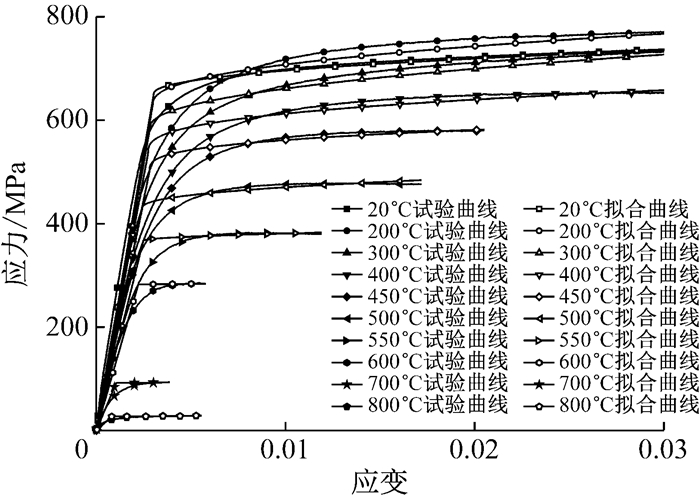
|
图 14 应力-应变关系试验曲线与通用模型曲线比较 Fig.14 Comparison of the stress-strain curves and the general model curves |
本文采用稳态拉伸法对国产Q550高强钢进行试验研究,得到20~800 ℃钢材的弹性模量、屈服强度、极限强度、断后伸长率、应力-应变关系曲线和试验现象.通过试验值与国内外现行规范以及相关高强钢研究成果的对比发现,现有钢材高温性能参数模型对国产Q550高强钢并不适用.因此,本文分别采用多项式模型和美国国家标准与技术研究院的钢材高温通用材料模型进行拟合,得到高温下Q550钢力学性能参数的数学模型,可用于应用Q550钢材的钢结构抗火安全评估与设计.
| [1] |
李国强, 王彦博, 陈素文, 等. 高强度结构钢研究现状及其在抗震设防区应用问题[J]. 建筑结构学报, 2013, 34(1): 1 LI Guoqiang, WANG Yanbo, Chen Suwen, et al. State of the art on research of high strength structural steels and key issues of using high strength steel in seismic structures[J]. Journal of Building Structures, 2013, 34(1): 1 |
| [2] |
SCHNEIDEI R, LANGE J. Constitutive equations of structural steel S460 at high temperatures[J]. Journal of Structural Fire Engineering, 2011, 2(3): 217 DOI:10.1260/2040-2317.2.3.217 |
| [3] |
SCHNEIDEI R, LANGE J. Constitutive equations and empirical creep law of structural steel S460 at high temperatures[C]// Structures in Fire 2010. East Lansing: Destech Publication Inc., 2010: 703-710.
|
| [4] |
SCHNEIDEI R, LANGE J. Material and creep behavior of S460 in case of fire-experimental investigation and analytical modeling[C]// International Conference Application of Structural Fire Engineering. Prague: Cost, 2011: 55-60.
|
| [5] |
QIANG Xuhong, BIJLAARD F, KOLSTEIN H. Dependence of mechanical properties of high strength steel S690 on elevated temperatures[J]. Construction & Building Materials, 2012, 30(30): 73 |
| [6] |
QIANG Xuhong, BIJLAARD F, KOLSTEIN H. Deterioration of mechanical properties of high strength structural steel S460N under steady state fire condition[J]. Materials & Design, 2012, 36: 438 |
| [7] |
QIANG Xuhong, BIJLAARD F, KOLSTEIN H. Deterioration of mechanical properties of high strength structural steel S460N under transient state fire condition[J]. Materials & Design, 2012, 40: 521 |
| [8] |
RANAWAKA T, MAHENDRAN M. Experimental study of the mechanical properties of light gauge cold-formed steels at elevated temperatures[J]. Fire Safety Journal, 2009, 44(2): 219 DOI:10.1016/j.firesaf.2008.06.006 |
| [9] |
KANKANAMGE N.D, MAHENDRAN M. Mechanical properties of cold-formed steels at elevated temperatures[J]. Thin-Walled Structures, 2011, 49(49): 26 |
| [10] |
CHIEW S P, ZHAO M S, LEE C K. Mechanical properties of heat-treated high strength steel under fire/post-fire conditions[J]. Journal of Constructional Steel Research, 2014, 98: 12 DOI:10.1016/j.jcsr.2014.02.003 |
| [11] |
陈凯. 变截面门式钢刚架结构抗火性能及实用设计方法研究[D]. 上海: 同济大学, 2000. CHEN Kai. Research on fire resistance of steel portal frames with tapered members[D]. Shanghai: Tongji University, 2000. http://www.doc88.com/p-4032290271673.html |
| [12] |
李国强, 张晓进, 蒋首超, 等. 高温下SM41钢的材料性能试验研究[J]. 工业建筑, 2001, 31(6): 57 LI Guoqiang, ZHANG Xiaojin, JIANG Shouchao, et al. Experimental studies of the material properties of SM41 steel at elevated temperatures[J]. Industrial Construction, 2001, 31(6): 57 |
| [13] |
李国强, 李明菲, 殷颖智, 等. 高温下高强度螺栓20MnTiB钢的材料性能试验研究[J]. 土木工程学报, 2001, 34(5): 100 LI Guoqiang, LI Mingfei, YIN Yingzhi, et al. Experimental studies on the behavior of high-strength bolts made of 20MnTiB steel at elevated temperatures[J]. China Civil Engineering Journal, 2001, 34(5): 100 |
| [14] |
CHEN J, YOUNG B, UY B. Behavior of high strength structural steel at elevated temperatures[J]. Journal of Structural Engineering, 2006, 7(3): 331 |
| [15] |
中国人民共和国国家质量监督检验检疫总局, 中国国家标准化管理委员会. 金属材料室温拉伸试验方法: GB/T 228. 1-2010[S]. 北京: 中国标准出版社, 2010. General Administration of Quality Supervision, Inspection and Quarantine of the People's Republic of China. Metallic materials-Tensile testing-Part 1: method of test at room temperature: GB/T 228. 1-2010[S]. Beijing: Standard Press of China, 2010. |
| [16] |
中国人民共和国国家质量监督检验检疫总局, 中国国家标准化管理委员会. 金属材料高温拉伸试验方法: GB/T4338-2006[S]. 北京: 中国标准出版社, 2006. General Administration of Quality Supervision, Inspection and Quarantine of the People's Republic of China. Metallic materials—tensile testing at elevated temperature: GB/T 4338-2006[S]. Beijing: Standards Press of China, 2006. |
| [17] |
同济大学, 中国钢结构协会防火与防腐分会. 建筑钢结构防火技术规范: CECS200[S]. 北京: 中国计划出版社, 2006. Tongji University, Sub-society for Corrosion and Fire Resistance of China Steel Construction Society. Technical code for fire safety of steel structure in buildings: CECS200[S]. Beijing: China Planning Press, 2006. |
| [18] |
European Committee for Standardization. Eurocode 3-design of steel structures-part 1-2: general rules-structural fire design: EN 1993-1-2[S]. Brussels: CEN, 2005.
|
| [19] |
Australian Standards. Steel structures: AS4100[S]. Sydney: Standards of Australia, 1998.
|
| [20] |
European Convention for Constructional Steelwork. Technical committee—fire safety of steel structures, European recommendation for the fire safety of steel structure—calculation of the fire resistance of loadbearing element and structural assemblies exposed to the standard fire[S]. Amsterdam: ECCS, 1983.
|
| [21] |
American Institution of Steel Construction. Specification for structural steel buildings[S]. Chicago: AISC, 2005.
|
| [22] |
CHOE L, ZHANG C, LUECKE W E, et al. Influence of material models on predicting the fire behavior of steel columns[J]. Fire Technology, 2017, 53: 375 DOI:10.1007/s10694-016-0568-4 |
| [23] |
ZHANG C, CHOE L, GROSS J L. High-temperature material constitutive models for structural-fire analysis[C]// Proceedings of 8th International Conference on Structures in Fire. Shanghai: Tongji University, 2016: 616-623.
|
 2018, Vol. 46
2018, Vol. 46

